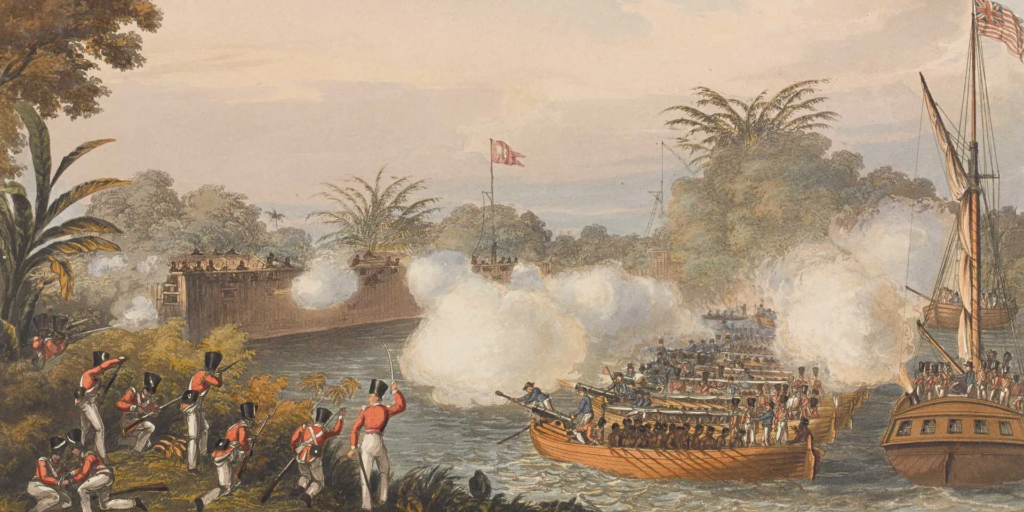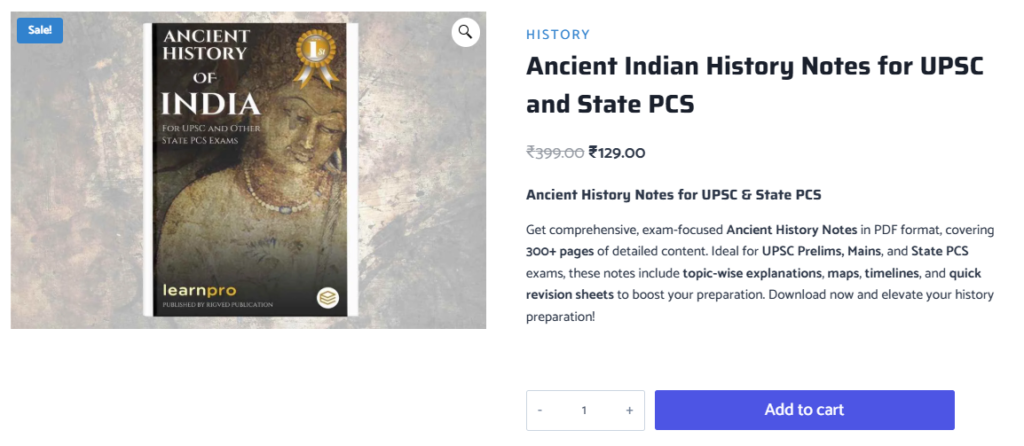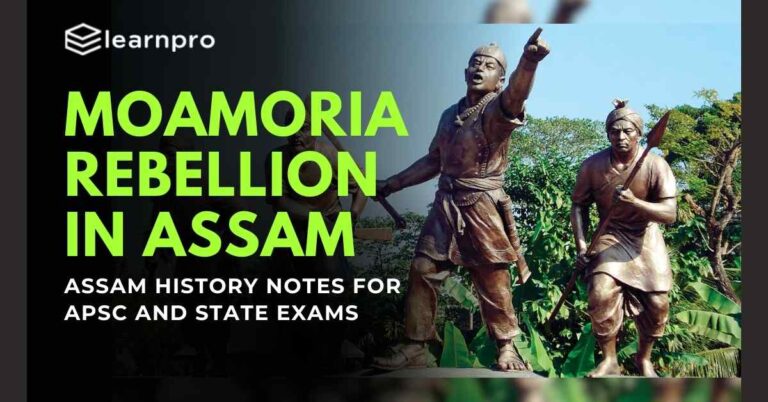October 25, 2025 9:30 am
Introduction to Treaty of Yandabo 1826
The Treaty of Yandabo, signed on February 24, 1826, stands as a watershed moment in the “History of Assam and Ahom rule,” a document that extinguished the flickering embers of a 600-year-old dynasty and ignited Assam’s colonial era under British rule. For centuries, the Ahom kingdom had reigned over the Brahmaputra Valley, its Swargadeos (heavenly kings) forging a legacy of resilience against invaders like the Mughals. Yet, by the early 19th century, this once-mighty realm lay in ruins, ravaged by the Moamoria Rebellion and the brutal Burmese invasions that followed. The treaty emerged from the First Anglo-Burmese War (1824–1826), a conflict that pitted the expanding British East India Company against the ambitious Konbaung Dynasty of Burma. Its signing in the small village of Yandabo, near the Irrawaddy River, marked more than a military settlement—it was the death knell of Ahom sovereignty.
- APSC Notification 2025 OUT | APSC CCE 2025 Exam Date, Vacancy, Exam Pattern, Syllabus & Eligibility
- APSC Exam 2025: A Complete Guide for Aspirants
- APSC CCE Final Result 2023: Assam Public Service Commission Declares Results for Combined Competitive Examination
- APSC Result 2025: Date, Download PDF, and Merit List
- APSC Application Form 2025: Expected Release Date , How to Apply
- APSC Cut Off 2025: Expected Cut off, Everything You Need to Know
- APSC Exam 2025: Key Dates, Eligibility, Admit Card, Syllabus, and Exam Pattern
- APSC Syllabus 2025: Subject-Wise Topics for APSC Prelims, Mains, and Interview

Why does this treaty resonate today? It didn’t just redraw maps; it redefined Assam’s destiny, ending an era of indigenous rule and thrusting the region into the orbit of British imperialism. The Ahom kingdom, already weakened by internal strife and foreign occupation, vanished as a political entity, its lands ceded to a colonial power eager to exploit Assam’s resources. In this 3000-word exploration, we’ll trace the historical context of Assam’s decline, uncover the causes that led to the treaty, spotlight the key figures who shaped it, detail its terms, and assess its far-reaching consequences. The Treaty of Yandabo is a lens into a transformative juncture—one that closed a chapter of the “History of Assam and Ahom rule” and opened another.
- APSC Notification 2025 OUT | APSC CCE 2025 Exam Date, Vacancy, Exam Pattern, Syllabus & Eligibility
- APSC Exam 2025: A Complete Guide for Aspirants
- APSC CCE Final Result 2023: Assam Public Service Commission Declares Results for Combined Competitive Examination
- APSC Result 2025: Date, Download PDF, and Merit List
- APSC Application Form 2025: Expected Release Date , How to Apply
- APSC Cut Off 2025: Expected Cut off, Everything You Need to Know
- APSC Exam 2025: Key Dates, Eligibility, Admit Card, Syllabus, and Exam Pattern
- APSC Syllabus 2025: Subject-Wise Topics for APSC Prelims, Mains, and Interview
Historical Context – Assam Before the Treaty
The “History of Assam and Ahom rule” is a tale of grandeur and gradual decline, and by the early 19th century, the Ahom kingdom teetered on the edge of oblivion. Founded in 1228 by Sukaphaa, a Tai prince who united the Brahmaputra Valley’s diverse tribes, the Ahom dynasty had thrived for centuries, peaking with victories like the Battle of Saraighat in 1671. Yet, the 18th century brought cracks that widened into chasms. The Moamoria Rebellion (1769–1805) was a devastating blow, halving the population, crippling the Paik system, and splintering the kingdom with the rise of the Matak Rajya. By the time the rebellion subsided, the Ahom monarchy was a shadow of its former self, its economy shattered and its rulers, like Gaurinath Singha, reliant on fleeting British aid. .

Into this vacuum stormed the Burmese invasions, a series of incursions from 1817 to 1826 that plunged Assam into chaos. The Konbaung Dynasty, under kings like Bagyidaw, sought to expand westward, targeting Assam, Manipur, and Arakan. The first invasion in 1817, led by Badan Chandra Borphukan—an Ahom noble turned traitor—saw Burmese forces overrun the region. Two more invasions followed, each more ruthless, with massacres, famine, and destruction reducing Assam’s population by a third. Chandrakanta Singha, the reigning Ahom king, fled multiple times, his authority evaporating as Burmese occupation tightened its grip. By 1824, the once-proud kingdom was a desolate battleground, its people desperate for reprieve.
Meanwhile, the British East India Company watched with growing alarm. Based in Bengal, the British viewed the Burmese advance as a threat to their trade routes and northeastern frontier. The First Anglo-Burmese War loomed as Assam’s turmoil intersected with colonial ambitions. The Ahom kingdom, too weak to resist or recover, became a pawn in a larger imperial game. This prelude to the Treaty of Yandabo—a kingdom ravaged by rebellion and invasion—set the stage for a seismic shift in the “History of Assam and Ahom rule.” Explore the Ahom legacy further at .https://learnpro.in/history-of-assam/

Causes Leading to the Treaty of Yandabo
The Treaty of Yandabo wasn’t an isolated event but the culmination of forces that collided in the early 19th century, forever altering the “History of Assam and Ahom rule.” Its roots lay in Burmese aggression, British imperial strategy, and the Ahom kingdom’s collapse—a perfect storm that birthed the First Anglo-Burmese War and its decisive resolution.
The primary catalyst was Burmese expansionism. Under the Konbaung Dynasty, Burma pursued an ambitious westward push, eyeing Assam, Manipur, and Arakan as buffers against rivals. The Burmese invasions began in 1817, orchestrated by Badan Chandra Borphukan, who invited King Bagyidaw’s forces to settle an Ahom succession dispute. The invasions—three in total by 1824—devastated Assam, with Burmese troops pillaging villages, enslaving inhabitants, and triggering famine. Their aggression spilled into Manipur and Cachar, regions near British Bengal, alarming the colonial power. This unchecked conquest, detailed at , threatened regional stability.
Equally critical were British strategic interests. The East India Company, entrenched in Bengal since the 1757 Battle of Plassey, saw the Burmese advance as a direct challenge. Assam’s proximity to Calcutta, a vital trade hub, made its security paramount. The Burmese also raided Arakan, a coastal region near Chittagong, disrupting maritime commerce. By 1824, border skirmishes—such as Burmese attacks on British outposts in Cachar—pushed Governor-General Lord Amherst to act. The British aimed not just to repel the Burmese but to secure Assam and its resources, including potential tea lands, aligning with their expansionist vision.
The First Anglo-Burmese War (1824–1826) crystallized these tensions. Fought across Burma, Assam, and Manipur, it pitted British forces, under Major General Archibald Campbell, against Burmese armies led by Maha Bandula. Key battles—like the Siege of Rangoon in 1824 and the Battle of Danubyu in 1825, where Maha Bandula fell—tilted the war in Britain’s favor. The conflict’s cost, however, drained both sides, making a negotiated end appealing. .

Finally, the Ahom monarchy’s disintegration sealed Assam’s fate. After the Moamoria Rebellion, rulers like Chandrakanta Singha and Purandar Singha faced a fractured realm. Chandrakanta, deposed by the Burmese in 1818, briefly regained power with British help in 1819, only to flee again during later invasions. Purandar, his rival, lacked the resources to resist. By 1824, the Ahom kingdom was a hollow shell—its Paik system broken, its treasury empty, and its people ravaged. Unable to fend off the Burmese or assert independence, it became a prize for the war’s victor.
These causes—Burmese ambition, British opportunism, and Ahom collapse—converged to necessitate the Treaty of Yandabo, a resolution that ended the war and reshaped the “History of Assam and Ahom rule.”
Key Figures of the Treaty of Yandabo
The Treaty of Yandabo was shaped by individuals whose decisions and fates intertwined with the “History of Assam and Ahom rule.” From British commanders to Burmese generals and the last Ahom king, these figures navigated a conflict that ended an era.
Major General Archibald Campbell led the British forces during the First Anglo-Burmese War. A seasoned officer, he orchestrated victories at Rangoon and Danubyu, breaking Burmese resistance. As the war neared its end, Campbell negotiated the treaty in Yandabo, securing Assam and other territories for the East India Company. His pragmatic leadership ensured British dominance, setting the stage for colonial rule.
Maha Bandula, the Burmese military genius, was Campbell’s formidable foe. A national hero under King Bagyidaw, he commanded the Konbaung armies with brilliance, conquering Assam and threatening British frontiers. His death at Danubyu in 1825, struck by a rocket, turned the war’s tide, weakening Burma’s resolve and paving the way for the treaty. His loss was a decisive blow to Burmese ambitions.
Chandrakanta Singha, the last significant Ahom king, embodied the kingdom’s twilight. Crowned in 1811, he was ousted by Burmese forces in 1818, restored briefly with British aid, and displaced again by 1821. During the war, he oscillated between resistance and exile, his reign a casualty of Burmese occupation and Ahom decline. The treaty rendered him a figurehead, his dynasty extinguished.
David Scott, appointed the first British agent in Assam post-treaty, bridged the transition to colonial rule. Arriving in 1826, he administered Assam, balancing Ahom traditions with British policies. His efforts laid the groundwork for tea cultivation and infrastructure, shaping Assam’s colonial future. .
These figures—Campbell’s strategy, Bandula’s valor, Chandrakanta’s fall, and Scott’s administration—wove the “History of Assam and Ahom rule” into a narrative of conquest and change.
The Treaty of Yandabo – Terms and Signing
The Treaty of Yandabo, signed on February 24, 1826, was a landmark in the “History of Assam and Ahom rule,” formalizing the end of the First Anglo-Burmese War and the Ahom kingdom. Inked in the village of Yandabo, 70 miles from Ava (Burma’s capital), it was a terse yet transformative agreement that shifted Assam’s fate.
Negotiated between Major General Archibald Campbell and Burmese envoys, the treaty followed months of grueling warfare. By late 1825, British victories—culminating in the capture of Prome—had pushed King Bagyidaw to the bargaining table. Signed aboard a British steamer, the document’s 11 articles outlined a new regional order. Key terms included: Burma ceding Assam, Manipur, Arakan, and Tenasserim to the East India Company; paying a one-million-pound indemnity; and renouncing claims to British territories. For Assam, Article 2 was pivotal: “The King of Ava cedes to the British Government the provinces of Assam, together with Manipur, Cachar, and Jaintia.”
This clause dissolved the Ahom kingdom as a sovereign entity. After centuries of rule, the Swargadeos’ lineage—embodied by Chandrakanta Singha—was relegated to history, their lands annexed without resistance. The treaty ended the Burmese occupation, which had tormented Assam since 1817, but replaced it with British dominion. On March 6, 1826, David Scott arrived as agent, marking the shift from Burmese chaos to colonial order.
The immediate aftermath saw British troops withdraw from Burma, while in Assam, the end of Burmese atrocities brought relief. Yet, the Ahom nobility, fragmented and powerless, could only watch as British administrators began reshaping the region. The treaty’s signing was less a negotiation than a capitulation, reflecting Burma’s exhaustion and Britain’s ascendancy—a moment that redefined the “History of Assam and Ahom rule.”
Consequences of the Treaty of Yandabo
The Treaty of Yandabo reshaped the “History of Assam and Ahom rule,” its ink drying on the tombstone of Ahom sovereignty and the cornerstone of British colonial rule. Its consequences rippled through Assam’s politics, economy, and society, forging a legacy that endures.
The most immediate impact was the end of Ahom rule. The treaty stripped the Swargadeos of power, reducing figures like Chandrakanta Singha to pensioned relics. The British East India Company annexed Assam, establishing direct control under agents like David Scott. This marked the definitive close of a 600-year dynasty, a casualty of the Moamoria Rebellion and Burmese invasions.
Economically, the treaty ushered in transformation. The British identified Assam’s potential for tea, with Charles Bruce planting the seeds of an industry that boomed by the 1840s. Railways and roads followed, linking Assam to colonial markets. While this modernized the region, it exploited local labor, reshaping agrarian life.
Socially and culturally, British governance introduced English education and Christian missions, altering Assam’s fabric. The sattras, once central to neo-Vaishnavism, waned under colonial policies, though their influence persisted. The British also integrated Assam into British India, standardizing administration but eroding indigenous autonomy.
The treaty’s long-term legacy was Assam’s incorporation into a global empire, a process cemented by the 1858 shift to Crown rule. It ended the “History of Assam and Ahom rule” as an independent narrative, binding the region to India’s colonial and post-colonial story—a dual tale of loss and modernization.
Conclusion
The Treaty of Yandabo in 1826 was a defining stroke in the “History of Assam and Ahom rule,” a pact that extinguished the Ahom kingdom and ignited Assam’s colonial chapter. Born from the First Anglo-Burmese War, it ended the torment of Burmese invasions but traded one occupier for another—the British East India Company. This 3000-word journey has traced Assam’s decline, the treaty’s causes, its key figures, its terms, and its sweeping consequences. It’s a story of an ancient dynasty’s fall and a region’s forced rebirth under imperial rule.
The treaty’s legacy is bittersweet: it closed a saga of Ahom resilience, yet opened Assam to modernity—tea plantations, railways, and global connectivity. For every loss of sovereignty, there was a gain in infrastructure, a duality that defines Assam’s modern identity. Today, the “History of Assam and Ahom rule” lives on in its people, its culture, and its landscapes, a testament to a past both proud and poignant.






